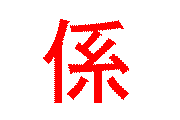Incompatibility Issues
The first thing a person should know is that Cantonese does not
translate directly into Mandarin. True, Cantonese and Mandarin
grammar are very similar. Aside from a few important exceptions,
word order between the two languages is compatible. However, there
are a large number of words that are used in Cantonese which are not
used in Mandarin. So, despite the similar grammars, Cantonese
sentences cannot usually be converted word for word and become
comprehendible Mandarin sentences.
What this section of the website looks at are patterns and systematic
differences. Below are a number of language features that point
out the limitations of this approach to learning one dialect from
another.
| Very essential parts of the
languages are different. For example, the equative verb "
haih
"
in Cantonese and "
shi
" in Mandarin come from
different roots and are based on a different character. The
possessive particle ("
ge
" in Cantonese and "
de
"
in Mandarin) are likewise different. Even a simple sentence like
"John is my friend" would be have important differences.
Below are the Cantonese and Mandarin versions of that sentence where the
points of conflict are in red.
Cantonese:
John
haih ngohge pahngyauh
.
Mandarin:
John shi wode pengyou
.
There are several other such differences. The words for
"this" and "that" are different. The location
prefix "
hai
" in Cantonese and "
zai
"
in Mandarin are from different roots. Perhaps most noticeable is
that Cantonese and Mandarin do not use the same negation particle.
|

The character for "shi:
the "to be" verb in Mandarin.
|
|

The character for "haih":
the "to be" verb in Cantonese
|
Additionally, while Cantonese and Mandarin grammar are mostly
compatible, there are some points where they are not. One such divergence
which will be encountered regularly is the construction for "to not
have." Cantonese uses a single character (
mouh
);
Mandarin uses the character for "to have" and a special negator
prefix. This small grammatical divergence has great ramifications.
Because most words in Chinese are composed of two morphemes, Cantonese can make
great use of the "
mouh
" character, combining it with
other morphemes to create complete ideas. While the Mandarin construction
can sometimes duplicate the Cantonese form, there are cases where the two are
not compatible.
What this means for Cantonese speaking learners of Mandarin is
that even completely mastering the information contained in the conversion
charts does not allow one to speak proper Mandarin directly from oral
Cantonese. Spoken Mandarin follows the grammar of written Chinese, which
makes these conversion tools great for changing written Chinese read in the
Cantonese dialect and converting it to colloquial Mandarin. These charts
will also serve as a powerful vocabulary building tool.
Home
Friends Service
Bookstore
© copyright 2002-2006
all rights reserved

